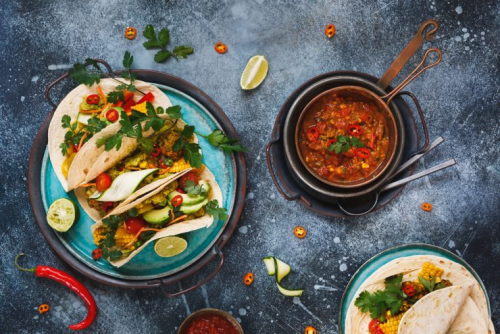Perhaps you had a conversation with your doctor, you stepped on the scale and didn’t like what you saw, or your favorite jeans no longer fit as well as they used to (or not at all). Whatever the reason, you’ve decided it’s time to slim down. And that means “diet.” Choosing the right weight-loss plan can be a challenge. You may even think it means cutting out foods you love, avoiding all treats, and being “perfectly” on plan to drop the LBs.
Do you really have to give up your favorite foods to lose weight? What diet is best for long-term weight loss? That’s the million-dollar question right there.
BREAKING: Diabetes Breakthrough Leaves Doctors Speechless - Try This Tonight
And what if you love food? You love to tempt your tastebuds with a wide range of flavors, textures, smells. Maybe you even love being in the kitchen cooking and baking, and the idea of giving it all up spins you out of control until you decide that dieting isn’t for you.
Don’t Give Up Your Favorite Foods!
Many diets are all about what you give up—from favorite foods to entire food groups. Go low-carb and give up all breads, pastas, and desserts. Go dairy-free—down to the tablespoon of half and half in your morning coffee. Go vegetarian—even if you feel left out and isolated at every family or community BBQ.
Unfortunately, highly restrictive diets can quickly backfire. When you restrict foods you enjoy, when you do slip up (or after you’ve lost the weight), you may find yourself eating uncontrollably or even bingeing. Have you ever watched a bodybuilder go through a buffet line after a competition or photo shoot? Or watched someone binge on the weekend after strictly avoiding carbs all week? (Perhaps you’ve observed yourself and wondered how you could possibly pack in so much food in one sitting?)
Research supports that giving up all your favorite foods can actually prevent people from successfully losing weight in the long run. Even anticipating that you’re going to have to give up foods you love when you start a diet can cause you to binge on foods (known as the Last Supper effect).
Not labeling specific foods as forbidden or off-limits also helps prevent you from starting to obsess over those foods (as we tend to crave things we can’t have—even if we’re the ones who made them off-limits).
Instead of depriving yourself, a proper weight-loss plan is about choosing how to incorporate those favorite foods into the best weight-loss plan for you. Here are some tips to help you do just that:
How to Choose a Weight-Loss Plan If…
You Like Deep-Fat Friend Foods
From French fries to chicken fingers, fried foods can be found aplenty in almost any restaurant and frozen section. Unfortunately, when food is submerged completely in hot oil, it soaks a lot of the oil up, leaving a plate full of calories and often unhealthy refined oils on your plate.
Sure, you can dry bake your foods, but where’s the fun in that? By adding a light coating of breading and perhaps an egg wash and then spritzing your food with a touch of oil, you can enjoy the crispy flavor of fried foods without busting way past your calorie goals in one sitting.
Oven “fried” potatoes are one option, of course, but you can really have some fun by making your own sweet potato fries, onion rings, oven-fried zucchini, or fried chicken.
You Are Nuts for Nuts
Nuts are part of just about every healthy weight-loss plan. Unfortunately, however, when consumed in excess, they’re also very high in calories, which may lead you to believe they’ll bring your weight loss to a screeching halt.
You don’t want to consume nuts by the handful (or bagful), and you’ll definitely want to avoid those with all sorts of additives (e.g., refined oils and preservatives), but research has found that consuming nuts regularly helps people manage their weight, decrease blood pressure, and improve long-term health. A half-cup of walnuts per day, for example, actually helped prevent weight gain and reduced waist circumference when combined with a lower-calorie diet. This is because nuts are particularly good at helping you feel satiated after eating.
To prevent yourself from overdoing it, just remember to measure out a serving of nuts rather than just tossing in a handful or snacking on them directly from the bag. If it helps, when you bring nuts into the house, you can divide them into separate single-serving containers that are perfect for a grab-and-go, quick, healthy snack.
You Are a Pasta-holic
The problem with pasta isn’t necessarily the carbs. Instead, it’s often the serving size, especially when you are eating out. At many restaurants, one plateful of pasta is enough for at least two people, providing nearly 1,000 calories.
Of course, you can choose a healthy pasta alternative (there are several delicious ones, from spaghetti squash to pasta made with beans). But if nothing else will cure your craving, then choose a whole-grain, fiber-rich variety of pasta, and measure out your appropriate serving size, eat mindfully to enjoy every bite, and avoid going back for seconds.
If you’re afraid you’ll be left wanting more, you can also try doing half and half. That is, go with half pasta and half zoodles. The high-fiber vegetable will fill you up, you’ll get significantly more nutrients, and because your plate is so full, you’ll enjoy the illusion of eating more food than you are. And, you’ll still get to enjoy the full flavor of your favorite pasta.
You Can’t Live Without Bread
There are plenty of people who thrive on a low-carb diet, and ditching bread isn’t even a big deal. Others, however, feel tortured every time they walk by a bakery or even the bread section at the local grocery store. Others are fine without bread—until they’re told they can’t ever have it.
When it comes to a healthy, balanced diet, bread doesn’t have to be the enemy. Rather, it’s about choosing which breads to make and eat. When your bread is made with healthy whole grains, you’re getting loads of nutrition, including fiber, several B vitamins, iron, and magnesium.
Ezekiel bread is one common option as it’s made with sprouted whole grains. Other healthy options include bread made with barley, buckwheat, rye, or millet. And if you’re willing to bake your own bread, you can remove traditional flour altogether and play around with gluten-free options like teff, quinoa, amaranth, nut or bean flours, and more.
You Need Bacon in Your Life
I actually know someone who loves bacon so much, he had the word bacon tattooed across his belly. If you’re one of the many, many bacon lovers (even if not enough for a tattoo), you don’t have to give up bacon to lose weight, though you may want to eat it differently.
For example, make bacon a garnish rather than the star of the meal. You can chop up bacon to sprinkle over your eggs, serve a tablespoon on top of a salad, or even add a tablespoon of cooked bacon on top of your grilled chicken or sautéed with some onions with broccoli, Brussels sprouts, or kale. You’ll get to enjoy all the smokey goodness while leaving many of the calories behind.
TRENDING: Shed 42 lbs In 30 Days With This Simple Night-time Pill
Two slices of bacon add ~108 calories to your meal. But you can easily get the flavor by cooking up a bit less and saving hundreds of calories over the week. And if you do want to go with a full serving from time to time, find comfort in the fact that bacon also provides some good nutrition, including several B vitamins and healthy fats as well as quality proteins. This is especially true if you choose bacon from organic, pastured, humanely-raised pigs with minimal additives and no sugar or MSG.
You Love Cheese and Milk
If you’re like me, you can’t imagine putting anything other than half and half in your morning coffee. Sure, that adds calories. However, if you go with just one tablespoon and forgo added sugar, that makes your morning beverage just 22 calories. You could do worse. For example, you could load it up with a sugar-loaded alternative or just try to match the flavor by adding more of an alternative that you don’t love. For instance, if you had to add a ¼ cup of 1% milk, that weighs in at 28 calories.
As with many foods, giving up something you love may not be necessary for your weight-loss plan. Instead, focus on serving size and cutting back in other areas that are less of a sacrifice. For example, you may be perfectly happy with almond or oat milk in your smoothie or oatmeal, but giving up cream in your coffee makes you want to weep. In that case, keep the cream in your coffee and use a lower-calorie milk alternative in places where you won’t miss it.
What about cheese? With over 300 options of cheese, there’s a large spectrum of healthy cheeses (e.g., cottage cheese) to unhealthy cheeses (e.g., processed cheese slices). So, it depends on which cheese you choose.
Because cheese is typically a high-calorie, high-fat option, just remember that a little goes a long way. One simple way to enjoy cheese without going overboard is to choose a stronger cheese, so it’s easy to use less. For example, if your recipe calls for a cup of cheddar cheese, if you choose extra sharp cheddar cheese, you may enjoy the creamy flavor with a mere quarter cup, shaving off over 300 calories from the recipe.
You Are a Chocoholic
When you need to improve your health and lose weight, decreasing (or even eliminating) sugar is on every single plan. And perhaps the most loved sweet treats is chocolate. If you’re a member of the chocolate cult, that may just be too difficult to contemplate. You may even decide this whole dieting thing isn’t for you.
Fortunately, there’s no need to give up chocolate entirely. You can easily sneak in chocolate without hindering your diet at all—and you may even be eating healthier than ever before.
For example, you can mix just a little milk or Greek yogurt into your chocolate ice cream protein powder for a rich, creamy pudding. If you want it to be even more decadent, you can stir in some cocoa nibs or a teaspoon of nut butter. You can also indulge in a square of dark chocolate, knowing its rich flavor is a great source of healthy antioxidants. Finally, there are several delicious chocolate recipes right in this blog.
Choosing How You Eat for Your Weight-Loss Plan
Yes, what you eat is important to a healthy lifestyle and losing weight. But so is how you eat. In fact, one of the simplest ways to continue eating foods you love is to change how you eat them. For example, to eat more healthfully long term, no matter what you’re eating:
- Avoid distractions
- Eat more slowly
- Practice mindful eating
- Eat or prepare most meals at home
- Drink plenty of water, especially before you eat or when you think you may be hungry (it’s common to mistake thirst for hunger)
- Experiment with intermittent fasting
- Consume more protein with each meal, especially during your first meal of the day
- Listen to your body and eat when you’re hungry and stop when you’re full (which may take some practice)
- Keep a food diary and track not only what you ate but how you felt after eating (e.g., energetic, lethargic, bloated, focused, etc.)
- Practice portion control
- Make smart substitutions to decrease calories
- Don’t just allow, but enjoy your favorite foods up to two times every week
Weight-Loss Plans are About Progress, Not Perfection
If you’re trying to be perfect all of the time with your diet and exercise program, you’re likely to fail. After an accidental slip up, you can feel like you already failed and then just throw in the towel.
BREAKING: 1 Cup of This Melts Belly and Arm Fat (Take Before Bed)
A healthy, long-term weight-loss plan leaves room for fun foods. Just don’t go overboard, watch those serving sizes, and perhaps most importantly, enjoy them mindfully when you do eat them.
It can also help if you keep “trigger” foods (i.e., the foods that are too hard to stop eating once you start) out of your home. An ice cream cone and the local ice cream parlor with friends or family isn’t going to ruin your diet, but keeping a gallon of ice cream in the fridge could.
Don’t be surprised that as your menu changes, and you add more vegetables and less junk foods, the foods you used to crave just don’t have the same appeal. Perhaps they lead to feeling less energetic, some stomach distress, or they simply no longer taste as good as you remember.
And if you never feel that way, then it’s not only okay but beneficial to permit yourself to eat your favorite foods—and as long as you do so consciously and mindfully, you can still lose those stubborn pounds. Research and anecdotal reports have, in fact, shown that fun foods (aka “cheat” meals) can be an effective way to help you shed weight.









